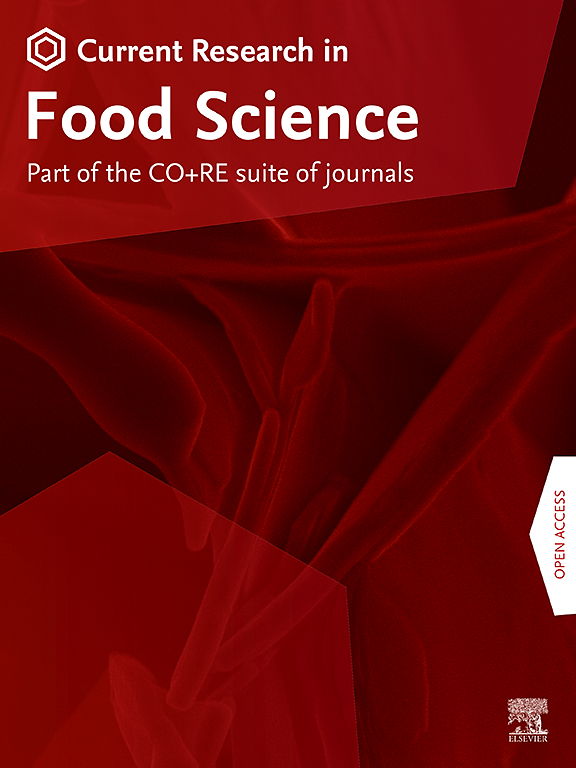Efficacy of Larimichthys crocea TASOR protein-derived peptide FAM286 against Staphylococcus aureus
IF 6.2
2区 农林科学
Q1 FOOD SCIENCE & TECHNOLOGY
引用次数: 0
Abstract
Staphylococcus aureus (S. aureus) is a major foodborne pathogen, could lead cause of intestinal infections in humans. Antimicrobial peptides, as emerging antimicrobial agents, are gradually replacing traditional agents due to their highly effective and safe antimicrobial activity. In this study, a novel peptide, designated as FAM286, was identified from TASOR protein of Larimichthys crocea, which had a strong antimicrobial activity against S. aureus with a minimum bactericidal concentration (MBC) of 3.9 μg/mL and completed bacteria killing by treatment for 1.5 h. The FAM286 could increase the permeability and disrupt the integrity of cell membranes. The cell showed aggregation phenomenon and entered the apoptosis stage. In addition, the non-bactericidal concentration of FAM286 could effectively inhibit the formation of biofilm and remove mature biofilm. Molecular docking experiments further verified the binding sites of FAM286 to S. aureus biofilm proteins SarA, AgrA, and Hld. FAM286 could also bind the bacterial DNA in an embedded manner, disrupting the structure of DNA and leading to the death of bacteria. This study comprehensively evaluated the antimicrobial mechanism of the FAM286 against S. aureus and provided a theoretical basis for the prevention and control of S. aureus.

大鲵TASOR蛋白衍生肽FAM286抗金黄色葡萄球菌的作用
金黄色葡萄球菌(S. aureus)是一种主要的食源性病原体,可引起人类肠道感染。抗菌肽作为新兴的抗菌药物,由于其高效、安全的抗菌活性,正逐渐取代传统的抗菌药物。本研究从crocea Larimichthys TASOR蛋白中鉴定出一种新的抗菌肽FAM286,该肽对金黄色葡萄球菌具有较强的抗菌活性,其最低杀菌浓度(MBC)为3.9 μg/mL,经1.5 h处理可完全杀死细菌。FAM286可增加细胞膜的通透性,破坏细胞膜的完整性。细胞出现聚集现象,进入凋亡阶段。此外,非杀菌浓度的FAM286能有效抑制生物膜的形成,去除成熟的生物膜。分子对接实验进一步验证了FAM286与金黄色葡萄球菌生物膜蛋白SarA、AgrA、Hld的结合位点。FAM286还能以嵌入方式结合细菌DNA,破坏DNA结构,导致细菌死亡。本研究全面评价FAM286对金黄色葡萄球菌的抑菌机制,为金黄色葡萄球菌的防治提供理论依据。
本文章由计算机程序翻译,如有差异,请以英文原文为准。
求助全文
约1分钟内获得全文
求助全文
来源期刊

Current Research in Food Science
Agricultural and Biological Sciences-Food Science
CiteScore
7.40
自引率
3.20%
发文量
232
审稿时长
84 days
期刊介绍:
Current Research in Food Science is an international peer-reviewed journal dedicated to advancing the breadth of knowledge in the field of food science. It serves as a platform for publishing original research articles and short communications that encompass a wide array of topics, including food chemistry, physics, microbiology, nutrition, nutraceuticals, process and package engineering, materials science, food sustainability, and food security. By covering these diverse areas, the journal aims to provide a comprehensive source of the latest scientific findings and technological advancements that are shaping the future of the food industry. The journal's scope is designed to address the multidisciplinary nature of food science, reflecting its commitment to promoting innovation and ensuring the safety and quality of the food supply.
文献相关原料
公司名称
产品信息
索莱宝
Kanamycin
麦克林
Nisin
 求助内容:
求助内容: 应助结果提醒方式:
应助结果提醒方式:


